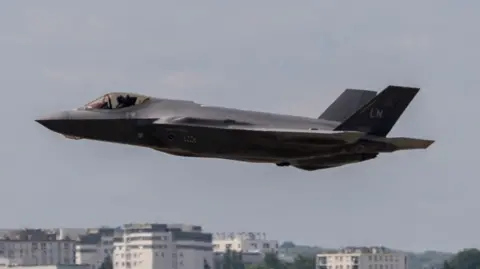Defense correspondent
 Nathan Laine / Bloomberg via Getty Images
Nathan Laine / Bloomberg via Getty ImagesThe British government must buy 12 new fighter planes that can be equipped with nuclear bombs and join the NATO airborne nuclear mission.
Downing Street says this decision is “the greatest strengthening of the United Kingdom’s nuclear posture in a generation”.
The new F-35A jets can still carry conventional weapons, but have the possibility of being equipped with nuclear bombs made in the United States.
The decision will be announced by the Prime Minister at the NATO summit which will take place this week in the Netherlands.
The NATO airborne nuclear mission involves allied aircraft equipped with American B61 bombs stored in Europe.
Seven other countries, including the United States, Germany and Italy, already use double-capacity planes.
The use of nuclear weapons would require the authorization of the NATO nuclear planning group as well as the American president and the British Prime Minister.
The United States has already pre-positioned B61 bombs in Europe. Justin Bronk of Think Think Tank of the Royal United Defense Institute (RUSI) said that the United States would still control its release and use in the event of war. This can be controversial with the United Kingdom that depends on the United States.
Prime Minister Sir Keir Starmer said: “In an era of radical uncertainty, we can no longer take peace for acquired, which is why my government is investing in our national security.”
Defense secretary, John Healey, told BBC Breakfast on Wednesday that investment “would strengthen NATO collection deterrence which has just had this nuclear capacity”.
Speaking in The Hague before a NATO summit, Healey said that the program would support 20,000 jobs and more than 100 companies across the United Kingdom in the supply chain.
NATO Secretary General Mark Rutte described the announcement “yet another solid British contribution to NATO”.
The new fast jets will be based in Raf Marham in Norfolk.
The decision to buy F -35A jets will be considered a victory for the RAF – which makes the fighter for a longer range of the longer range who can draw a greater variety of bombs and missiles.
The F-35B variant, currently operated by the RAF and the Royal Navy Fleet Air Arm, has a shorter range and can transport less weapons.
With its short take-off and vertical landing, the F-35B was initially chosen because it can operate off the two aircraft carriers of the Royal Navy-HMS Queen Elizabeth and Prince Hms of Wales-while the F-35AS can operate on a land landing track.
Great Britain currently has only one delivery system for larger strategic nuclear weapons-launched from its Vanguard class submarines via trident ballistic missiles.
While the trident missiles are manufactured and maintained in the United States, the missile warheads are manufactured and maintained in the United Kingdom. Successive governments have insisted that their use will not depend on the United States-it is therefore described as the “independent deterrence” of Great Britain.
The RAF jets were able to transport smaller tactical nuclear weapons until 1998 – when the bombs designed by the United Kingdom and made WE177 bombs were removed from the service.
Mr. Bronk said it would take time to the RAF “to resume nuclear game”. He added that the most obvious advantage for the purchase of the United Kingdom’s F-35AS will be their longer range and the fact that they can carry a wider range of conventional weapons.
The decision follows the Defense Strategic Examination, which, according to the defense secretary, said “confirmed that we are faced with new nuclear risks, with other states increasing, modernizing and diversifying their nuclear arsenals”.
And Tuesday, the government published a national security strategy In which he said that the United Kingdom should “actively prepare for the possibility that the British homeland is threatened direct, potentially in a wartime scenario”.
Sir Keir is committed to reaching a new NATO target to spend 5% of the United Kingdom’s GDP on national security by 2035.
At the top of NATO, 32 member counties should agree on the objective, which sees 3.5% go to the basic defense, the rest on the defense areas.




